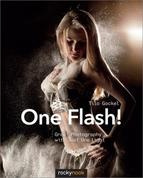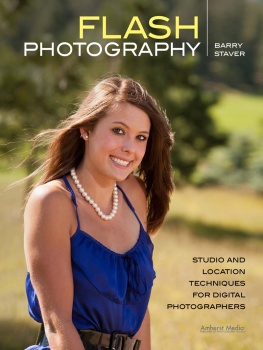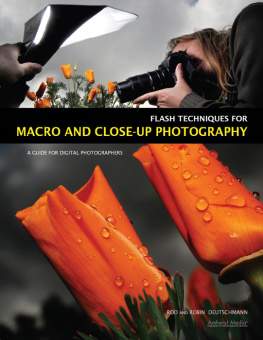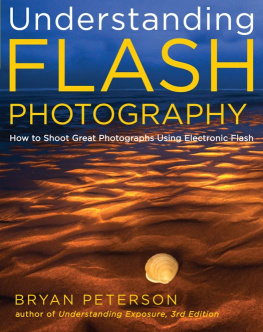Gerd Ludwig
minus 2/3
The Invisible Flash:
Crafting Light for Photographers in the Field

minus 2/3
Gerd Ludwig
gerdludwig.com
Gerd Ludwig is represented by National Geographic Creative and the Fahey/Klein Gallery.
Editor: Jocelyn Howell
Project manager: Lisa Brazieal
Marketing manager: Jessica Tiernan
Layout and type: Hespenheide Design
Cover design: Helmut Kraus, www.exclam.de
ISBN: 978-1-68198-068-3
1st Edition (1st printing, October 2016)
2016 Gerd Ludwig
All images Gerd Ludwig
Rocky Nook Inc.
1010 B Street, Suite 350
San Rafael, CA 94901
USA
www.rockynook.com
Distributed in the U.S. by Ingram Publisher Services
Distributed in the UK and Europe by Publishers Group UK
Library of Congress Control Number: 2016930699
All rights reserved. No part of the material protected by this copyright notice may be reproduced or utilized in any form, electronic or mechanical, including photocopying, recording, or by any information storage and retrieval system, without written permission of the publisher.
Many of the designations in this book used by manufacturers and sellers to distinguish their products are claimed as trademarks of their respective companies. Where those designations appear in this book, and Rocky Nook was aware of a trademark claim, the designations have been printed in caps or initial caps. All product names and services identified throughout this book are used in editorial fashion only and for the benefit of such companies with no intention of infringement of the trademark. They are not intended to convey endorsement or other affiliation with this book.
While reasonable care has been exercised in the preparation of this book, the publisher and author assume no responsibility for errors or omissions, or for damages resulting from the use of the information contained herein or from the use of the discs or programs that may accompany it.
This book is printed on acid-free paper.
Printed in China
In memory of Ethan Hoffman
ACKNOWLEDGMENTS
Thank you to Molly Peters, Johanna Renoth, Maxim Ludwig, Maxim Kuznetsov, Sergey Rezanov, Lauren Greenfield, Lauren Wendle, Douglas and Franoise Kirkland, and the National Geographic magazine Editors and Photographic Staff
CONTENTS
INTRODUCTION
In early 1989 I was an established photographer married to a photographer with whom I had a child, our son Maxim, and I found myself at a party of mostly established colleagues on the Lower East Side of Manhattan. As one would expect at a party full of photographers, everybody was taking pictures. My friend Ethan Hoffman was snapping away along with the others, but I noticed something different about him. He moved with great ease and used his on-camera strobe with confidence. I walked over to Ethan, complimented him on his grace, and confessed that, even with my years of experience, I lacked any understanding and self-assurance when using a strobe. I had to admit that I had never taken a successful image with a strobe. Sage-like and full of mystery, Ethan said to me, Today, all you need to know is minus 2/3. At the time, I had no idea what he meant. Im sure my face conveyed my confusion because Ethan offered proofhe took a picture of me with my then-wife and son using the strobe and promised to send it to me.

Ethan Hoffman
Later that week, I received a slide in the mail and was totally stunned. How could a single image, shot with a strobe, be so perfectly exposed? I began researching the recently introduced through-the-lens (TTL) technology that Ethan had described to me, which revolutionized flash photography. The process of TTL is actually very technical, but Ill offer an abbreviated explanation. The flash is fired and hits the subject. When the light hits your subject, it then bounces immediately back to the camera itself, making its way through the lens where it hits the film plane. The light from the film bounces to a sensor that measures the light as the exposure builds on the film itself. The sensor and software then determine when the exposure is sufficient. At this point, the computer turns off the flash. Remember, this all happens at the speed of light.
Once I had amassed an understanding of this, in theory, I went to the now-defunct Advance Camera in Manhattan and bought one of the best TTL strobes on the market to begin putting what I had learned into practice. I soon found that when using a TTL strobe at its automatic, unadjusted setting, it powers out too strong of a flash. This gives the image a noticeable and somewhat boring, intrusive, and excessively strobed flash look. Even the first TTL flashes had a built-in setting to increase or decrease the flash outputthats when I realized what Ethan meant when he mentioned minus 2/3.
The human eye has the ability to adjust to varying light intensitiesfrom light to dark and vice versaand continue to recognize details. It takes a moment, but the ability is there. We all know the extreme: when walking from bright daylight into a dark room, it takes a moment to see the details inside. Photography does not traditionally afford that same luxury. Though a background may be beautifully lit with ambient light, the subject in the foreground can be immersed in shadow. When the background in this sort of situation is properly exposed on film, the subject in the foreground is silhouetted. Even with todays digital technology, opening up the shadows in a RAW file is only possible to a certain extent, and you cannot achieve the same result as you can when you use a flash. I used flash in the early days primarily to open up the shadows in an image for additional detail. I wanted to create an invisible strobe, meaning one that was unnoticeable, one that didnt draw attention to the technique behind it. As I soon discovered, Ethans formula of minus 2/3 is an ideal basic setting, one that many professional photographers feel comfortable with and that allows you to achieve enough strobe output without creating an overblown flash effect.
I quickly began to experiment, reflecting the strobe from the ceiling and bouncing it off a wall. I also discovered that the general strobe output was cooler than the ambient light in the situations I photographed. It added a cool, slightly bluish tint that I didnt want. This discovery initiated my foray into using gels to offset the coolness.
Over the years, I learned I could use the flash to add emphasis to specific areas in an image. I was able to direct the viewers attention, create distinction, and craft more beautiful light, all while keeping the necessary equipment to a minimum.
Due to the nature of my work for National Geographic , I often carry extensive luggage (clothing for sub-zero temperatures, protective gear, etc.), so I prefer lightweight, standard, shoe-mounted flashes. I need to make it as easy as possible for me to travel and shoot. As a photographer focusing on diverse cultural and environmental stories, I am often confronted with a wide range of situationsfrom classic street photography to portraiture, from scenes in bustling nightclubs to intimate moments in churchesmany of which require additional, fast, and flexible lighting.










